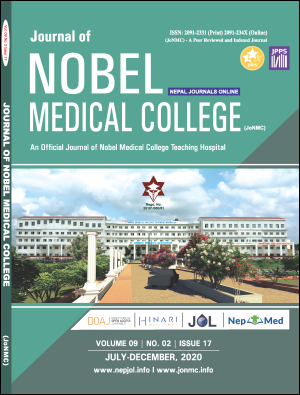Study on Knowledge and Prevalence of Computer Vision Syndrome among Computer Operators in Nobel Medical College Teaching Hospital, Biratnagar, Nepal
DOI:
https://doi.org/10.3126/jonmc.v9i2.33386Keywords:
Asthenopia, Backache, Dry eye, Refractive errorsAbstract
Background: The eye and vision related problems that results from continuous use of computers and other visual display terminals for extended period of time leads to computer vision syndrome. Due to rapid digitalization in human life, the risk of developing it has also increased in many folds. So, with an aim of determining the prevalence and level of awareness of computer vision syndrome among computer users along with their attitude and practices to prevent it, this study was conducted in the office employees who use computer for a considerable period of time.
Materials and Methods: A hospital based observational descriptive study was conducted in the out-patient department of Ophthalmology in Nobel Medical College and Teaching Hospital, Biratnagar, where 105 employees working in different work stations of same institution were enrolled. A questionnaire and the clinical findings were used to collect data.
Results: About 80% of the employees were using computer for about (8-11) hours per day. Prevalence of computer vision syndrome noted was (92.4%) with low level of knowledge (85.7%) about it. About 45% of them wore glasses for their refractive errors but attitude and practices in work place to prevent the bad effects of using visual display terminals were found to be lacking (53.3%). Burning sensation in the eye, headache, ocular irritation and itching and neck, shoulder or back pain were the common symptoms. Around (60-70)% of the eyes tested positive for dry eye.
Conclusion: Lack of awareness of computer vision syndrome and lack of personal protective measures were associated with its high level of prevalence.
Downloads
Downloads
Published
How to Cite
Issue
Section
License
JoNMC applies the Creative Commons Attribution (CC BY) license to works we publish. Under this license, authors retain ownership of the copyright for their content, but they allow anyone to download, reuse, reprint, modify, distribute and/or copy the content as long as the original authors and source are cited.




